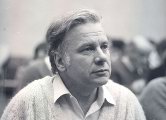 |
VII-th International Conference "SOLITONS, COLLAPSES AND TURBULENCE: Achievements, Developments and Perspectives" (SCT-14) in honor of Vladimir Zakharov's 75th birthday
August, 04-08, 2014 Chernogolovka, Russia |
Modelling of squall with the generalised kinetic equation
Date/Time: 11:50 07-Aug-2014
Abstract:
We study the long-term evolution of random wind waves using the new generalised kinetic equation (GKE). The GKE derivation does not assume quasi-stationarity of a random wave field [1]. In contrast with the Hasselmann kinetic equation, the GKE can describe fast spectral changes occurring when a wave field is driven out of a quasi-equilibrium state by a fast increase or decrease of wind, or by other factors. In these cases, a random wave field evolves on the dynamic timescale typical of coherent wave processes, rather than on the kinetic timescale predicted by the conventional statistical theory. Besides that, the generalised theory allows to trace the evolution of higher statistical moments of the field, notably the kurtosis, which is important for assessing the risk of freak waves and other applications.
A new efficient and highly parallelised algorithm for the numerical simulation of the generalised kinetic equation is presented and discussed. Unlike in the case of the Hasselmann equation, the algorithm takes into account all (resonant and nonresonant) nonlinear wave interactions, but only approximately resonant interactions contribute to the spectral evolution. However, counterintuitively, all interactions contribute to the kurtosis. Without forcing or dissipation, the algorithm is shown to conserve the relevant integrals. We show that under steady wind forcing the wave field evolution predicted by the GKE is close to the predictions of the conventional statistical theory, which is applicable in this case. In particular, we demonstrate the known long-term asymptotics for the evolution of the spectrum. When the wind forcing is not steady (in the simplest case, an instant increase or decrease of wind occurs), the generalised theory is the only way to study the spectral evolution, apart from the direct numerical simulation. The focus of the work is a detailed analysis of the fast evolution after an instant change of forcing, and of the subsequent transition to the new quasi-stationary state of a wave field. It is shown that both increase and decrease of wind lead to a significant transient increase of the dynamic kurtosis, although these changes remain small compared to the changes of the other component of the kurtosis, which is due to bound harmonics.
A special consideration is given to the case of the squall, i.e. an instant and large (by a factor of 2--4) increase of wind, which lasts for $O(10^2)$ characteristic wave periods. We show that fast adjustment processes lead to the formation of a transient spectrum, which has a considerably narrower peak than the spectra developed under a steady forcing. These transient spectra differ qualitatively from those predicted by the Hasselmann kinetic equation under the squall with the same parameters.
1. S.Annenkov, V.Shrira (2006) Role of non-resonant interactions in evolution of nonlinear random water wave fields, J. Fluid Mech. 561, 181--207.
A new efficient and highly parallelised algorithm for the numerical simulation of the generalised kinetic equation is presented and discussed. Unlike in the case of the Hasselmann equation, the algorithm takes into account all (resonant and nonresonant) nonlinear wave interactions, but only approximately resonant interactions contribute to the spectral evolution. However, counterintuitively, all interactions contribute to the kurtosis. Without forcing or dissipation, the algorithm is shown to conserve the relevant integrals. We show that under steady wind forcing the wave field evolution predicted by the GKE is close to the predictions of the conventional statistical theory, which is applicable in this case. In particular, we demonstrate the known long-term asymptotics for the evolution of the spectrum. When the wind forcing is not steady (in the simplest case, an instant increase or decrease of wind occurs), the generalised theory is the only way to study the spectral evolution, apart from the direct numerical simulation. The focus of the work is a detailed analysis of the fast evolution after an instant change of forcing, and of the subsequent transition to the new quasi-stationary state of a wave field. It is shown that both increase and decrease of wind lead to a significant transient increase of the dynamic kurtosis, although these changes remain small compared to the changes of the other component of the kurtosis, which is due to bound harmonics.
A special consideration is given to the case of the squall, i.e. an instant and large (by a factor of 2--4) increase of wind, which lasts for $O(10^2)$ characteristic wave periods. We show that fast adjustment processes lead to the formation of a transient spectrum, which has a considerably narrower peak than the spectra developed under a steady forcing. These transient spectra differ qualitatively from those predicted by the Hasselmann kinetic equation under the squall with the same parameters.
1. S.Annenkov, V.Shrira (2006) Role of non-resonant interactions in evolution of nonlinear random water wave fields, J. Fluid Mech. 561, 181--207.
Attachments:
Authors
(no additional information)(no additional information)
Contact webmaster
